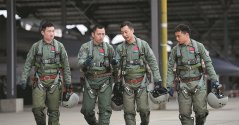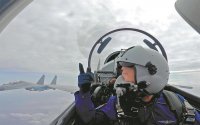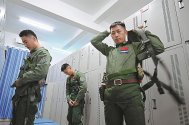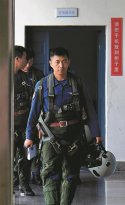I don't think there should be such a hard and fast distinction between them. Modern weapons carry enough sensors on board to do their own targeting in the terminal phase (most readily seen when contrasting SARH and ARH AAMs). You don't have to "lock" a carrier with an over-the-horizon radar - the data it gives is sufficient to launch an AShBM and have it take care of targeting with its own sensors.Tracking before targeting.
You are using an out of date browser. It may not display this or other websites correctly.
You should upgrade or use an alternative browser.
You should upgrade or use an alternative browser.
PLA Air Force news, pics and videos
- Thread starter Jeff Head
- Start date
Interesting ... I know Longtian AB only as a forward operational base and alleged home of the 80th Fendui, a J-6W/B-6 UCAV unit, but in fact I haven't heard anything since years.
Lots of cool footage and single frames of "inside" facilities including missile assembly (PL-12 at least), manufacturing floors, composite materials, assembly using augmented reality, wind tunnels, and drone command stations. Some building interiors for AVIC look downright futuristic. There was one frame given for an interior shot. Office spaces look decent too.
The most impressive is the conventional wind tunnel facility they're showing.
Lieutenant Colonel Qiu Linhui received his latest honorary title in August, becoming one of the People's Liberation Army's 12"best revolutionary soldiers in the new era".
Before receiving the new title, the 35-year-old fighter jet pilot had won a host of other honors from the PLA Air Force and had been regarded as one of the top aviators in the Chinese military.
Born in June 1986, Du joined the PLA Air Force in September 2004 and was then sent to a flight academy. After graduating from the academy, he was assigned to an Air Force fighter jet unit.
In 2017, his fine skills and remarkable performance earned Du a promotion to the deputy commander of the Du Fengrui Regiment, an elite Air Force unit that was named after an air combat hero. The next year, he was named the unit's 26th commander.
During his service in the regiment, Du achieved several breakthroughs in training and combat exercises.
One widely reported example is when the unit commissioned its first J-16 strike aircraft, Du spent a lot of time studying and learning about the new equipment. After practicing flight maneuvers, he decided to replace the traditional adaptive training method with a new approach that integrates technical learning, hardware familiarization and tactical training.
As a result, the new approach enabled his pilots to familiarize themselves with the aircraft in a shorter period of time, while also improving the efficiency of the training program, Du's superiors said.
In the Air Force's annual aerial combat contest in 2018 and the annual land-strike competition in 2019, Qiu cooperated with his backseat weapon operator to defeat a number of elite pilots from other Air Force units. He won the championship for the two top contests.
Headed and guided by Qiu, pilots in the Du Fengrui Regiment are always motivated by esprit de corps and the pursuit of excellence. They strive to become top aviators like their commander.
Several pilots in the regiment have since been decorated by the Air Force thanks to their outstanding fighting skills.
The aircraft flown by Du's regiment-the J-16 multirole strike fighter-is one of the best hardware items deployed by the PLA Air Force. Developed by Aviation Industry Corp of China, the jet is equipped with advanced radar, electronic and weapon systems.
The tandem-seat plane is reported to have made its maiden flight in 2011 and is believed to have entered service in 2015. Its public debut was in July 2017 when the aircraft took part in a massive parade to mark the 90th anniversary of the PLA's founding.




Top designers for China's advanced warplanes on Wednesday updated the market on the production status for the J-20 stealth fighter jet, domestically developed engines for the Y-20 large transport aircraft and next-generation aircraft carrier-based fighter jet at the ongoing Airshow China in Zhuhai, South China's Guangdong Province.
Responding to an inquiry from the Global Times concerning the production capacity of the J-20 at a press conference at the airshow, Wang Haitao, deputy designer of the aircraft, said that China's aviation industry can satisfy any level of demand from the PLA Air Force.
The research and development period for aviation equipment is usually long, but now with advances in industrial technology, China has accelerated this process, Wang noted.
"Particularly for equipment like the J-20, we need to do it faster in all aspects, including designing, production, testing and crafting," Wang said.
Tang Changhong, chief designer of the Y-20 aircraft, revealed at the press conference that the plane will be equipped with two types of domestically developed engines, both of which are undergoing flight tests that have been progressing smoothly.
After being equipped with these engines, the Y-20's capabilities have received a boost respect to fuel-efficiency, range and maximum takeoff weight, Tang said.
When asked about China's next-generation aircraft carrier-based fighter jet, Sun Cong, the chief designer of the J-15, China's first-generation aircraft carrier-based fighter jet, said at the press conference that "When the aircraft is ready, people will get to see it."
"This year, people should be able to see good news on the next-generation aircraft carrier-based fighter jet," said Sun, who is also the chief designer of the FC-31, China's second stealth fighter jet.
The FC-31 has been a long-rumored candidate to become the country's next-generation carrier-based fighter since its flight performance debut at the Airshow China 2014.
Well that shed a lot more smoke than light.
Top designers for China's advanced warplanes on Wednesday updated the market on the production status for the J-20 stealth fighter jet, domestically developed engines for the Y-20 large transport aircraft and next-generation aircraft carrier-based fighter jet at the ongoing Airshow China in Zhuhai, South China's Guangdong Province.
Responding to an inquiry from the Global Times concerning the production capacity of the J-20 at a press conference at the airshow, Wang Haitao, deputy designer of the aircraft, said that China's aviation industry can satisfy any level of demand from the PLA Air Force.
The research and development period for aviation equipment is usually long, but now with advances in industrial technology, China has accelerated this process, Wang noted.
"Particularly for equipment like the J-20, we need to do it faster in all aspects, including designing, production, testing and crafting," Wang said.
Tang Changhong, chief designer of the Y-20 aircraft, revealed at the press conference that the plane will be equipped with two types of domestically developed engines, both of which are undergoing flight tests that have been progressing smoothly.
After being equipped with these engines, the Y-20's capabilities have received a boost respect to fuel-efficiency, range and maximum takeoff weight, Tang said.
When asked about China's next-generation aircraft carrier-based fighter jet, Sun Cong, the chief designer of the J-15, China's first-generation aircraft carrier-based fighter jet, said at the press conference that "When the aircraft is ready, people will get to see it."
"This year, people should be able to see good news on the next-generation aircraft carrier-based fighter jet," said Sun, who is also the chief designer of the FC-31, China's second stealth fighter jet.
The FC-31 has been a long-rumored candidate to become the country's next-generation carrier-based fighter since its flight performance debut at the Airshow China 2014.
escobar
Brigadier
WS-18 engine project still relevant?
Tang Changhong, chief designer of the Y-20 aircraft, revealed at the press conference that the plane will be equipped with two types of domestically developed engines, both of which are undergoing flight tests that have been progressing smoothly.
Last edited:
Top designers for China's advanced warplanes on Wednesday updated the market on the production status for the J-20 stealth fighter jet, domestically developed engines for the Y-20 large transport aircraft and next-generation aircraft carrier-based fighter jet at the ongoing Airshow China in Zhuhai, South China's Guangdong Province.
Responding to an inquiry from the Global Times concerning the production capacity of the J-20 at a press conference at the airshow, Wang Haitao, deputy designer of the aircraft, said that China's aviation industry can satisfy any level of demand from the PLA Air Force.
The research and development period for aviation equipment is usually long, but now with advances in industrial technology, China has accelerated this process, Wang noted.
"Particularly for equipment like the J-20, we need to do it faster in all aspects, including designing, production, testing and crafting," Wang said.
Tang Changhong, chief designer of the Y-20 aircraft, revealed at the press conference that the plane will be equipped with two types of domestically developed engines, both of which are undergoing flight tests that have been progressing smoothly.
After being equipped with these engines, the Y-20's capabilities have received a boost respect to fuel-efficiency, range and maximum takeoff weight, Tang said.
When asked about China's next-generation aircraft carrier-based fighter jet, Sun Cong, the chief designer of the J-15, China's first-generation aircraft carrier-based fighter jet, said at the press conference that "When the aircraft is ready, people will get to see it."
"This year, people should be able to see good news on the next-generation aircraft carrier-based fighter jet," said Sun, who is also the chief designer of the FC-31, China's second stealth fighter jet.
The FC-31 has been a long-rumored candidate to become the country's next-generation carrier-based fighter since its flight performance debut at the Airshow China 2014.
My interpretations:
1. Currently there is no real production capacity constraint for J-20. Any constraints would be budgetary.
2. WS-18 and WS-20 are both under flight testing now for Y-20. Both are better than D-30. (WS-20 should be better than WS-18).
3. The next-generation carrier-based fighter jet J-XY will take its maiden flight later this year, consistent with rumors earlier this year.
All good news for PLAAF/PLAN.
WS-118 engine project still relevant?
Domestic engine for H-6 series bombers. Also, replacement engines for existing Y-20's and H-6's.
